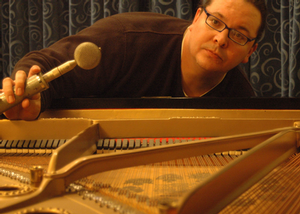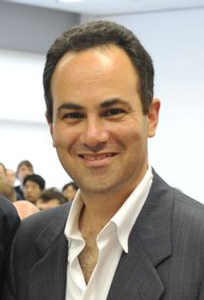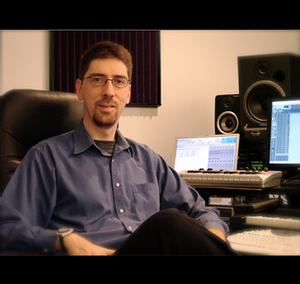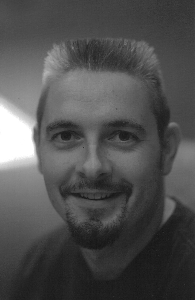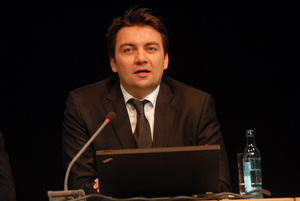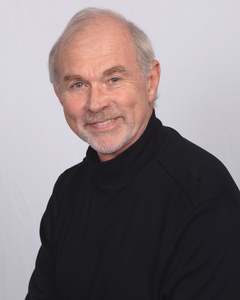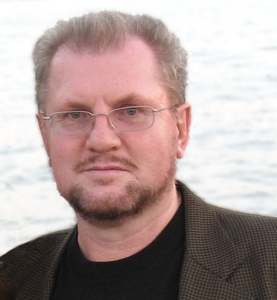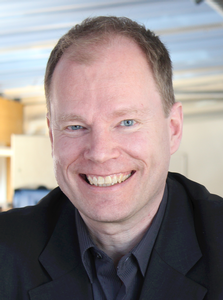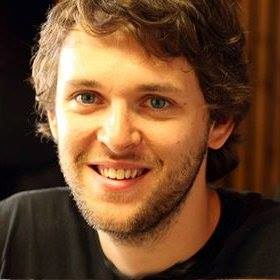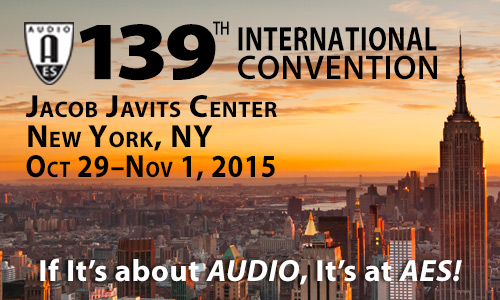
AES New York 2015
Tutorial Details
Thursday, October 29, 9:00 am — 10:30 am (Room 1A22)
T1 - Parametric Spatial Audio Processing: An Overview and Recent Advances
Presenters:Emanuël A. P. Habets, International Audio Laboratories Erlangen - Erlangen, Germany
Oliver Thiergart, International Audio Laboratories Erlangen - Erlangen, Germany
Abstract:
Parametric spatial processing is a promising and emerging technique that is fundamentally different from traditional spatial processing techniques. First, a relatively simple sound field model is adopted and the parameters of the model (such as for example the direction of arrival and diffuseness), are estimated in a time-frequency domain. Second, the estimated parameters are used to process the received microphone signals. The compact and efficient representation of the sound field can be used to develop algorithms for different applications. In this tutorial different sound field models and corresponding parameter estimation techniques will be presented. We will then focus on selected applications such as speech enhancement (directional filtering and dereverberation), acoustical zooming, spatial audio communication, and spatial sound reproduction. Finally, we show how one of the parametric representations can be used to create virtual microphone signals with user-defined pickup patterns.
Thursday, October 29, 9:00 am — 11:00 am (Room 1A10)
T2 - Microphones—Can You Hear the Specs?
Chair:Eddy B. Brixen, EBB-consult - Smørum, Denmark; DPA Microphones
Panelists:
Jürgen Breitlow, Georg Neumann Berlin - Berlin, Germany; Sennheiser Electronic - Wedemark, Germany
David Josephson, Josephson Engineering, Inc. - Santa Cruz, CA, USA
Helmut Wittek, SCHOEPS GmbH - Karlsruhe, Germany
Abstract:
There are lots and lots of microphones available to the audio engineer. The final choice is often made on the basis of experience or perhaps just habits. (Sometimes the mic is chosen because of the Looks...). Nevertheless, there is valuable information in the microphone specifications. This tutorial demystify the most important microphone specs and provide the attendee with up-to-date information on how these specs are obtained and understood and how the numbers relate to the perceived sound. It takes a critical look on how specs are presented to the user, what to look for, and what to expect.
Thursday, October 29, 9:30 am — 11:00 am (Room 1A06)
T3 - Vox Pop – Transducer Technologies and Their Connection to Vocal Performance Techniques
Presenter:Alex Case, University of Massachusetts Lowell - Lowell, MA, USA
Abstract:
For the first century of music recording, the sound of the recorded voice was very much driven by the capabilities of the audio technology available at the time. We are less limited by the extraordinary gear available today, leaving us with a broad range of creative options for tracking the all-important lead vocal. In this tutorial, Alex U. Case highlights what we might learn from audio history to drive our decisions for getting the right vocal sound at our next gig.
Thursday, October 29, 10:45 am — 12:15 pm (Room 1A22)
T4 - Interactive Music: Future Listening Experiences…
Presenters:Justin Paterson, London College of Music, University of West London - London, UK
Rob Toulson, Anglia Ruskin University - Cambridge, UK
Abstract:
Listeners have long been inspired to interact with commercial music and create new representations of popular releases. Vinyl offered many opportunities to reappropriate chart music, from scratching and tempo manipulation to mixing multiple songs. Nowadays, artists can engage their audience to interact with the music by offering mix stems for experimentation, a trend started by Nine Inch Nails in 2005 continuing to artists such as U2 in 2014. With the extended processing power of mobile devices, the opportunities for interactive music are limitless; both Bjork and Peter Gabriel have explored these new platforms in an interactive manner. This session will offer a history and context of interactive music and demonstrate potential future listening experiences. The presenters’ will also showcase their own funded research activities, which focus on a new interactive listening platform for commercial music, allowing the listener to manipulate mix stems, evaluate alternate mixes and explore additional music content.
Thursday, October 29, 11:15 am — 12:45 pm (Room 1A06)
T5 - Mic It & Record It!
Presenter:Ian Corbett, Kansas City Kansas Community College - Kansas City, KS, USA; off-beat-open-hats recording & sound reinforcement
Abstract:
Too many resources emphasize “instant” miking solutions, and tell the aspiring recording engineer to simply “mic it this way.” This often results in sounds that have to be significantly electronically processed to force them into place during mixing, degrading the integrity of the sound and making the mix process longer and more difficult than it otherwise might be. Topics discussed in this presentation will include the effects microphone technologies, mic techniques, and the recording room have on the recorded sound, and how they can be explored and exploited to capture the sound you actually need for the mix, improving your mix, and making mixing an easier and quicker process.
Thursday, October 29, 3:30 pm — 4:45 pm (Room 1A06)
T6 - From Student to Professional: Strategies and Best Practices for Matriculating into Your Audio Career
Presenter:John Krivit, New England Institute of Art - Brookline, MA, USA; Emerson College - Boston, MA, USA
Abstract:
AES Education Chair John Krivit shares tried and true methods for gaining your foothold in the audio industry. From industry trends that may alter your career trajectory to small gestures that can help shape how you are perceived, come find out how his students find work and launch successful careers.
Thursday, October 29, 5:00 pm — 6:30 pm (Room 1A06)
T7 - Keep it "Reel": The Ultimate Ultra-Portable Production/Recording Studio—From Idea to Final Master: How to Write, Sequence, Record, and Produce Your Music Using Only Your iPad
Presenter:Andrea Pejrolo, Berklee College of Music - Boston, MA, USA
Abstract:
In this highly interactive and hands on presentation you will learn the tools, techniques, tips, and tricks required to write, produce, and mix a song using only your iPad.
Through practical examples and scenarios you will learn how to: • Pick the best software for sequencing, producing and mixing your music • Pick the best iPad-compatible hardware tools (microphones, audio interface, MIDI interfaces, controller etc.) • Setup your mobile production/recording studio • Sketch your musical ideas • Use your iPad as a creative inspirational tool for music composition and sound design • Sequence and arrange your music ideas on your iPad • Use your iPad as a powerful virtual mixing console • Add audio plug-ins • Master your final mix.
Who should attend? Anyone who wants to create some great music with their iPads, from beginners to advanced. Attendees will learn: • How to assemble the ultimate ultra-portable multi-track recording rig • How to create a complete final production of a song using only the iPad • How to pick the right hardware and software available for mobile music production on the iPad • How to take advantage of the highly interactive interface of the iPad to streamline and enhance your creative process • How to share and interact with other music creators using solely the iPad and the cloud.
Thursday, October 29, 5:45 pm — 6:45 pm (Room 1A13)
T8 - Pop Music from 1000 Years ago: Recording Throat Singers and Instruments from Inner Mongolia
Presenter:Richard King, McGill University - Montreal, Quebec, Canada; The Centre for Interdisciplinary Research in Music Media and Technology - Montreal, Quebec, Canada
Abstract:
A case study of a modern recording session featuring centuries-old music from Inner Mongolian group Anda Union. Challenges and solutions as to how the voices were recorded in conjunction with the instruments, as each musician was simultaneously singing and playing. Horse head fiddles, calf skin drums and various strummed instruments were captured as part of the album. Throat singing, or "Hoomei," is performed in two fascinating manners—a sustained note is sung in the normal range and a second note is produced either one octave below, or in the range two octaves above where actual melodies may be produced in harmony with the held "tonic." Microphone choices, mix decisions, and production techniques will be discussed, video and audio examples will be provided.
Friday, October 30, 9:00 am — 10:30 am (Room 1A22)
T9 - Real Industry: How Media Technology Products Are Really Made
Chair:Jay LeBoeuf, Real Industry - San Francisco, CA, USA; Stanford University - San Francisco, CA, USA
Panelists:
Dave Hill, iZotope, Inc.
Daniel Rowland, LANDR - Montreal, Canada; NOIISE - Amsterdam, The Netherlands
Charles Van Winkle, Adobe Systems Incorporated - Minneapolis, MN, USA
Abstract:
How do leading audio companies bring products from ideation through commercialization? Join us we go behind the scenes at leading companies and explore key roles in the media tech industry including marketing, software development, hardware engineering, user experience, R&D, industrial design, and more. We'll feature 16 audio companies as our case studies.
Friday, October 30, 9:00 am — 10:30 am (Room 1A06)
T10 - 80s Redux – The Science Behind the Sound of Gated Drums, Yesterday and Today
Presenter:Alex Case, University of Massachusetts Lowell - Lowell, MA, USA
Abstract:
The sound of 1980s pop music includes a heavy dose of gated drums. The effect – part discovered, and part invented – is still relevant today. History teaches us how to overdo it. Alex U. Case wants you to hear it in its contemporary form. You won’t mix without it.
Friday, October 30, 9:00 am — 10:45 am (Room 1A21)
T11 - Main Microphone Techniques for 2.0 and 5.1
Presenter:Helmut Wittek, SCHOEPS GmbH - Karlsruhe, Germany
Abstract:
This tutorial will explain step-by-step, using many practical examples, what a suitable stereophonic microphone array can look like. With 2.0 stereo setups as the starting point, multichannel setups will also be introduced.
Many factors influence the choice of a stereophonic microphone setup, but the relevance of these factors can vary greatly depending on the application, such that there is never one single “correct” setup. Knowledge of various options gives a Tonmeister the ability to make optimal choices.
In this session the free iPhone App "Image Assistant" will be presented. It calculates the spatial characteristics of arbitrary stereophonic microphone arrays and auralizes the result. Moreover, the educational website "hauptmikrofon.de" is presented offering various comparative sound samples on the subject.
Friday, October 30, 11:00 am — 12:30 pm (Room 1A22)
T12 - Audio Forensics: Overview I
Chair:Jeff M. Smith, National Center for Media Forensics - Denver, CO, USA; University of Colorado Denver - Denver, CO, USA
Panelists:
Catalin Grigoras, University of Colorado at Denver - Denver, CO, USA
Gordon Reid, CEDAR Audio Ltd - Cambridge, UK
Abstract:
This tutorial will feature presenters engaged in various areas of audio forensics in lively discussion geared toward experts learning from one another and to benefit the introductory attendee. Tutorial Chair, Jeff M. Smith (National Center for Media Forensics, CU Denver) and chair of the Technical Committee on Audio Forensics, will present on Speaker Analysis and the application of Bayesian likelihood. Catalin Grigoras (NCMF, CU Denver) will present on the best practices and future challenges in forensic audio authentication. Gordon Reid (CEDAR Audio Ltd.) will present on noise reduction and speech enhancement techniques.
Friday, October 30, 12:15 pm — 1:15 pm (Room 1A12)
T13 - CANCELED
Friday, October 30, 2:00 pm — 3:30 pm (Room 1A22)
T14 - Audio Forensics: Overview 2
Chair:Eddy B. Brixen, EBB-consult - Smørum, Denmark; DPA Microphones
Panelists:
Durand R. Begault, Audio Forensic Center, Charles M. Salter Associates - San Francisco, CA, USA
Rob Maher, Montana State University - Bozeman, MT, USA
J. Keith McElveen, Wave Sciences - Charleston, SC, USA
Abstract:
This tutorial will feature presenters engaged in various areas of audio forensics in lively discussion geared toward experts learning from one another and to benefit the introductory attendee. Tutorial Chair, Eddy Brixen (EBB Consult) will present on auditory crime scene analysis. Rob Maher (Montana State University - Bozeman) will present on the analysis of recorded gunshots. Keith McElveen (Wavesciences, Corp.) will present on microphone applications. And Durand Begault (Audio Forensic Center) will wrap up some loose ends with a discussion of forensic audio miscellany including musicological forensics, warning signal audibility, acoustics, and more.
Friday, October 30, 4:15 pm — 5:45 pm (Room 1A22)
T15 - Brand Yourself: Marketing, Community, and Finding Your Niche as an Audio Engineer
Chair:Margaret Luthar, Sonovo Mastering - Stavanger, Norway
Panelists:
Erik Braund, Braund Sound
Adam Gonsalves, Telegraph Mastering - Portland, OR, USA
Jesse Lewis, Jesse's Bakery
Jon Lurie, The Wild Honey Pie - Brooklyn, NY, USA
Piper Payne, Coast Mastering - San Francisco Bay Area, CA
Abstract:
"Brand yourself" is a panel discussion on marketing and PR for engineers who are trying to further establish a regional presence, or a niche market within a larger geographical framework. You already have a market, and solid goals for your career. But how can you lock down a market for yourself? What troubles do you encounter in selling yourself to clients? How do you talk about rates? What is your role in helping establish a strong audio community in your region? The panel discussion will address these issues and more, as we navigate the often complicated world of being a "brand."
Friday, October 30, 5:15 pm — 6:15 pm (Room 1A08)
T16 - Control Systems and Electroacoustical Considerations for Large-Scale Loudspeaker Arrays: Past, Present & Future
Presenter:David Scheirman, Audio Engineering Society - Carlsbad, CA USA
Abstract:
System design evolution over four decades will be highlighted in a timeline for control and electroacoustical domains. In addition to historical review of control & monitoring processes, presentation bridges the gap from control-only networks to network digital audio, noting migration paths to beam-steerable line array elements now described as network endpoint devices. Tutorial also presents various enclosure and multi-box array topologies in use, as a broad-spectrum overview of technical developments taking place since the 6th International Conference (Sound Reinforcement, Nashville, 1988) and the 13th International Conference (Computer-controlled sound systems, Dallas, 1994). Each of these landmark AES events included content foreshadowing the development of today’s modern high-powered loudspeaker arrays that incorporate beam-steering technology. Recently-emerging trends will be examined, and potential future developments contemplated. Of potential interest to sound reinforcement technicians and system operators, installed-system designers, rental sound service company providers, and live-sound equipment product development engineers.
Saturday, October 31, 9:00 am — 10:30 am (Room 1A06)
T17 - Counter Clockwise – The Aesthetic Wonder and Technical Merit of Sounds Played Backwards
Presenter:Alex Case, University of Massachusetts Lowell - Lowell, MA, USA
Abstract:
We can learn from pop music’s many examples of artistic expression through the presentation of sounds While such sounds can’t happen in nature, they are a common studio creation. Alex U. Case demonstrates and discusses their strong musical value, and intriguing technical and perceptual advantages.
Saturday, October 31, 1:30 pm — 3:00 pm (Room 1A14)
T18 - Horns and Waveguides—History, Theory, and Technology
Presenter:Alexander Voishvillo, JBL/Harman Professional - Northridge, CA, USA
Abstract:
Horns are undoubtedly the oldest audio equipment. There are two major functions of horns: providing high-efficiency of horn-loaded transducers (often in combination with phasing plugs in compression drivers,) and providing desirable SPL coverage and directivity control. The tutorial will consider such aspects of horns as derivation of basic horn wave equation (Webster Equation), analysis of directivity control, the role of the wavefront at the throat of horn on directivity of horns at high frequencies, influence of the high-order modes on performance of horns, influence of the mouth diffraction on performance, comparison of axisymmetric, elliptical, and rectangular horns. Also nonlinear propagation effects due are analyzed and explained. Retrospective review of patents is carried out as well as the review of the technical achievements of JBL Professional in horns and waveguides technologies.
Saturday, October 31, 5:30 pm — 7:00 pm (Room 1A07)
T19 - Listening Tests—Understanding the Basic Concepts
Presenter:Jan Berg, Luleå University of Technology - Piteå, Sweden
Abstract:
Listening tests and other forms of data collection methods that rely on human responses are important tools for audio professionals, as these methods assist our understanding of audio quality. There are numerous examples of tests, either formally recommended and widely used, or specially devised for a single occasion. In order to understand listening tests and related methods, and also to potentially design and fully benefit from their results, some basic knowledge is required. This tutorial aims to address audio professionals without prior knowledge of listening test design and evaluation. The fundamentals of what to ask for, how to do it, whom to engage as listeners, what sort of results that may be expected and similar issues will be covered. The goal is to create an understanding of the basic concepts used in experimental design in order to enable audio professionals to appreciate the possibilities of listening tests.
Sunday, November 1, 9:00 am — 10:30 am (Room 1A06)
T20 - Righting a Wrong – Distortion, from Recording Accident to Rock and Roll Requirement
Presenter:Alex Case, University of Massachusetts Lowell - Lowell, MA, USA
Abstract:
Engineers obsess – as well we should – about proper gain staging and careful equipment maintenance and calibration, lest distortion should accidentally corrupt our audio. Engineers also embrace – we can’t help it – the deliberate use of distortion to express feelings not easily conveyed without it. A distortion accident became a distortion product, and almost overnight, distortion became de rigueur for so many styles of pop music. Alex U. Case details the creation of distortion and the technical and artistic ways to make it most effective.
Sunday, November 1, 9:00 am — 10:30 am (Room 1A10)
T21 - Advances in Semantic Audio and Intelligent Music Production
Chair:Ryan Stables, Birmingham City University - Birmingham, UK
Panelists:
Brecht De Man, Queen Mary University of London - London, UK
Joshua D. Reiss, Queen Mary University of London - London, UK
Thomas Wilmering, Queen Mary University of London - London, UK
Abstract:
Music Production can be a technically demanding process in which semantic and perceptual characteristics of a mix can have a nontrivial and nonlinear relationship to the parameters available to the producer. In order to improve access to these tools, and to encourage creativity, we can utilize semantic technologies in order to develop intelligent interfaces and production systems. In this tutorial, we present the tools and techniques currently being employed in the field of intelligent music production, along with an overview of the ways in which semantic audio data can be used to make the audio engineer’s workflow more intuitive. In addition to this, we introduce the Semantic Audio Feature Extraction (SAFE) DAW plug-ins for the collection, visualization and application of musical semantics data.
Sunday, November 1, 1:30 pm — 2:30 pm (Room 1A22)
T22 - Rethinking Audio Production: Common Mistakes that Hinder Progress
Presenter:Peter Dowsett, Audio Production Tips - London, UK
Abstract:
This tutorial will focus around educating students or amateurs, so that they re-evaluate what is really important when recording music. Discussion topics include: • It's about how you use the gear, not the gear itself • Proper gain-staging (both analogue and digital scales) • Cultivating vision • The importance of monitoring environment • Do everything for a reason (rather than because “that is what should be done”) • Good recordings start with good songs and arrangements • Fix problems as early as possible in the chain
